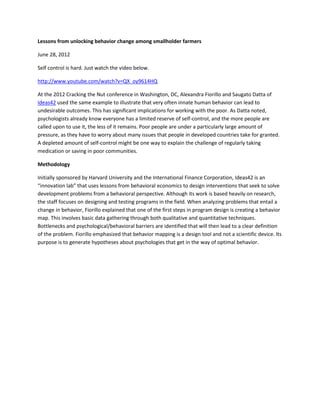
Lessons from unlocking behavior change among smallholder farmers
- 1. Lessons from unlocking behavior change among smallholder farmers June 28, 2012 Self control is hard. Just watch the video below. http://www.youtube.com/watch?v=QX_oy9614HQ At the 2012 Cracking the Nut conference in Washington, DC, Alexandra Fiorillo and Saugato Datta of Ideas42 used the same example to illustrate that very often innate human behavior can lead to undesirable outcomes. This has significant implications for working with the poor. As Datta noted, psychologists already know everyone has a limited reserve of self-control, and the more people are called upon to use it, the less of it remains. Poor people are under a particularly large amount of pressure, as they have to worry about many issues that people in developed countries take for granted. A depleted amount of self-control might be one way to explain the challenge of regularly taking medication or saving in poor communities. Methodology Initially sponsored by Harvard University and the International Finance Corporation, Ideas42 is an “innovation lab” that uses lessons from behavioral economics to design interventions that seek to solve development problems from a behavioral perspective. Although its work is based heavily on research, the staff focuses on designing and testing programs in the field. When analyzing problems that entail a change in behavior, Fiorillo explained that one of the first steps in program design is creating a behavior map. This involves basic data gathering through both qualitative and quantitative techniques. Bottlenecks and psychological/behavioral barriers are identified that will then lead to a clear definition of the problem. Fiorillo emphasized that behavior mapping is a design tool and not a scientific device. Its purpose is to generate hypotheses about psychologies that get in the way of optimal behavior.
- 2. Case study: Low fertilizer use among Kenyan farmers In one case study, the problem identified was that farmers in Kenya don’t use enough fertilizer. Based on a data collected by Ideas42, about 97% of farmers said they intended to use fertilizer in the next season. However, the percent of farmers who actually used fertilizer was only around 30%. The conventional explanation for this behavior was that farmers didn’t have enough money to purchase fertilizer. Through further investigation, Ideas42 redefined the problem. Farmers did have enough money just after harvest, but due to impatience (they wanted to spend the money right away) and procrastination (they waited too long after harvest to buy fertilizer at higher prices), they didn’t have enough money the next season. Ideas42 proposed a small, low-cost change to alter this behavior. Farmers were offered free delivery of fertilizer right after the previous harvest, which provided an incentive (lower cost and no hassle of transportation) to purchase fertilizer early when they had more money available. The result was a 47- 60% increase in fertilizer use. Considering alternative explanations In a variety of different contexts, smallholder farmers are not often maximizing their opportunities. This is because either they don’t know how, they know how but there are no incentives to change a behavior, or the solution is not intuitive. Ideas42 seeks to devise solutions through a behavioral economics-informed program design.
